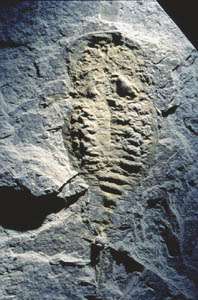Ancient wind held secret of life and death
.jpg)
(������ƵOrg.com) -- The mystery of how an abundance of fossils have been marvellously preserved for nearly half a billion years in a remote region of Africa has been solved by a team of geologists from the University of Leicester’s Department of Geology.
They have established that an ancient wind brought life to the region – and was then instrumental in the preservation of the dead.
Sarah Gabbott, Jan Zalasiewicz and colleagues investigated a site near the Table Mountains in South Africa. Their findings are published in the latest issue of the journal Geology.
Sarah Gabbott said: “Near Table Mountain in South Africa lies one of the world’s most mysterious rock layers. Just a few metres thick, and almost half a billion years old, it contains the petrified remains of bizarre early life-forms, complete with eyes and guts and muscles.
“We investigated why these animals are so marvellously preserved, when most fossils are just fragments of bone and shell? The answer seems to lie in a bitter wind, blowing off a landscape left devastated by a massive ice-cap.”

Gabbott and Zalasiewicz added that microscopic analysis of the shale layers using a specially designed ‘Petroscope’, obtained with funding from the Royal Society, revealed remarkable and so far unique structures – myriads of silt grains, neatly wrapped in the remains of marine algae.
The authors state: “The silt grains are sedimentary aliens - much bigger than the marine mud flakes in which they are embedded. They could only have been blown by fierce glacial winds on to the sea surface from that distant landscape. Arriving thick and fast, they carried nutrients into the surface waters, fuelling its prolific life. The deep waters, though, were overwhelmed by rotting, sinking vegetation, becoming stagnant and lifeless – ideal conditions to preserve the animal remains, down to their finest details. A cold wind, here, was key to both life and death.”
More information: Gabbott, S.E., Zalasiewicz, J., Aldridge, R.J. & Theron, H. 2010. Geology 38, 1103-1106.
Provided by University of Leicester




















